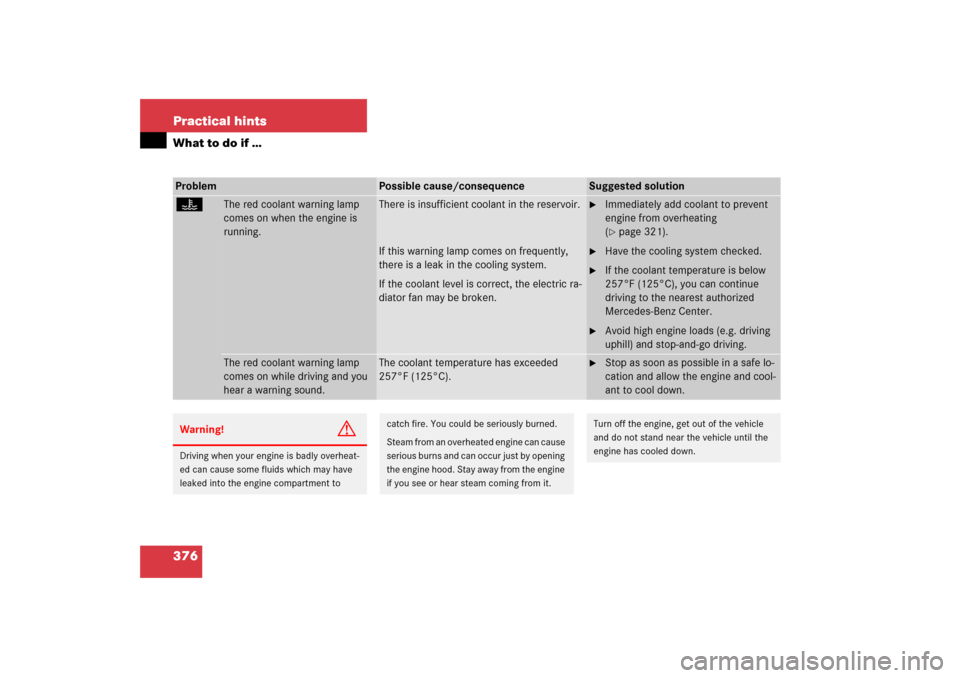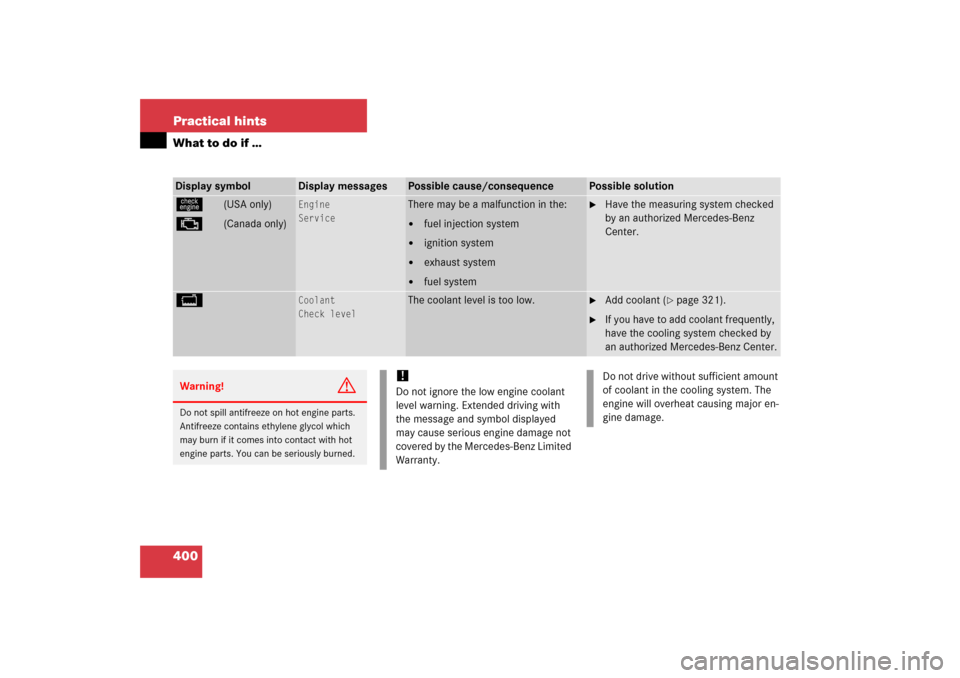Page 315 of 521
314 OperationAt the gas stationCoolant
For normal replenishing, use water (pota-
ble water quality). For more information on
coolant, see “Coolant level” (
�page 321)
and see “Fuels, coolants, lubricants etc.”
(
�page 482).
Engine oil level
For more information on engine oil level,
see “Engine oil” (
�page 316).Vehicle lighting
Check function and cleanliness. For more
information on replacing light bulbs, see
“Replacing bulbs” (
�page 431).
For more information, see “Exterior lamp
switch” (
�page 143).
Tire inflation pressure
For more information, see “Checking tire
inflation pressure” (
�page 335).
Page 317 of 521

316 OperationEngine compartment
Closing�
Let the hood drop from a height of ap-
proximately 1 ft (30 cm).
The hood will lock audibly.
�
Check to make sure the hood is fully
closed.
If you can raise the hood at a point
above the headlamps, then it is not
properly closed. Open it again and let it
drop with somewhat greater force.
Engine oil
The amount of oil your engine needs will
depend on a number of factors, including
driving style. Higher oil consumption can
occur when�
the vehicle is new
�
the vehicle is driven frequently at
higher engine speeds
Engine oil consumption checks should only
be made after the vehicle break-in period.
Warning!
G
If you see flames or smoke coming from the
engine compartment, or if the coolant tem-
perature gauge indicates that the engine is
overheated, do not open the hood. Move
away from vehicle and do not open the hood
until the engine has cooled. If necessary,
call the fire department.Warning!
G
The engine is equipped with a transistorized
ignition system. Because of the high voltage
it is dangerous to touch any components (ig-
nition coils, spark plug sockets, diagnostic
socket) of the ignition system�
with the engine running
�
while starting the engine
�
if ignition is “on” and the engine is
turned manually
Warning!
G
Be careful that you do not close the hood on
anyone.
iDo not use any special lubricant addi-
tives, as these may damage the drive
assemblies. Using special additives not
approved by Mercedes-Benz may
cause damage not covered by the
Mercedes-Benz Limited Warranty.
More information on this subject is
available at any Mercedes-Benz
Center.
Page 320 of 521

319 Operation
Engine compartment
1Oil dipstick
2Upper (max) mark
3Lower (min) mark
To check the engine oil level with the oil
dipstick, do the following:�
Open the hood (
�page 315).
�
Pull out oil dipstick1.
�
Wipe oil dipstick1 clean.
�
Fully insert oil dipstick1 into the
dipstick guide tube.
�
Pull out oil dipstick1 again after
approximately 3 seconds to obtain ac-
curate reading.
The oil level is correct when it is be-
tween the lower (min) mark3 and
upper (max) mark2 of oil dipstick1.
�
If necessary, add engine oil.
For adding engine oil, see “Adding en-
gine oil”.
For more information on engine oil, see
“Fuels, coolants, lubricants etc.”
(
�page 482).
For more information on messages in the
multifunction display concerning engine
oil, see the “Practical hints” section
(�page 383).Adding engine oiliThe filling quantity between the upper
and lower marks on the oil dipstick is
approximately 2.1 US qt. (2.0 l).
!Only use approved engine oils and oil
filters required for vehicles with
Maintenance System (U.S. vehicles) or
FSS PLUS (Canada vehicles). For a
listing of approved engine oils and oil
filters, refer to the Factory Approved
Service Products pamphlet in your ve-
hicle literature portfolio, or contact an
authorized Mercedes-Benz Center.
Using engine oils and oil filters of spec-
ification other than those expressly
required for the Maintenance System
(U.S. vehicles) or FSS PLUS (Canada
vehicles), or changing of oil and oil filter
at change intervals longer than those
called for by the Maintenance System
(U.S. vehicles) or FSS PLUS (Canada
vehicles) will result in engine damage
not covered by the Mercedes-Benz
Limited Warranty.
Page 322 of 521

321 Operation
Engine compartment
Coolant level
The engine coolant is a mixture of water
and anticorrosion/antifreeze. To check
the coolant level, the vehicle must be
parked on level ground and the engine
must be cool.
The coolant expansion tank is located on
the driver’s side of the engine compart-
ment.
1Coolant expansion tank
�
Using a rag, turn the cap slowly approx-
imately one half turn to the left to re-
lease any excess pressure.
�
Continue turning the cap to the left and
remove it.
The coolant level is correct if the level:�
for cold coolant: reaches the black
top part of the reservoir
�
for warm coolant: is approximately
0.6 in (1.5 cm) higher
�
Add coolant as required.
�
Replace and tighten cap.
For more information on coolant, see the
“Technical data” section (
�page 487).
Warning!
G
In order to avoid any possibly serious burns:�
Use extreme caution when opening the
hood if there are any signs of steam or
coolant leaking from the cooling system,
or if the coolant temperature gauge indi-
cates that the coolant is overheated.
�
Do not remove pressure cap on coolant
reservoir if coolant temperature is
above 158°F (70°C). Allow engine to
cool down before removing cap. The
coolant reservoir contains hot fluid and
is under pressure.
�
Do not spill antifreeze on hot engine
parts. Antifreeze contains ethylene gly-
col which may burn if it comes into con-
tact with hot engine parts.
�
Using a rag, slowly open the cap approx-
imately
1/2 turn to relieve excess pres-
sure. If opened immediately, scalding
hot fluid and steam will be blown out un-
der pressure.
Page 377 of 521

376 Practical hintsWhat to do if …Problem
Possible cause/consequence
Suggested solution
D
The red coolant warning lamp
comes on when the engine is
running.
There is insufficient coolant in the reservoir.
If this warning lamp comes on frequently,
there is a leak in the cooling system.
If the coolant level is correct, the electric ra-
diator fan may be broken.
�
Immediately add coolant to prevent
engine from overheating
(�page 321).
�
Have the cooling system checked.
�
If the coolant temperature is below
257°F (125°C), you can continue
driving to the nearest authorized
Mercedes-Benz Center.
�
Avoid high engine loads (e.g. driving
uphill) and stop-and-go driving.
The red coolant warning lamp
comes on while driving and you
hear a warning sound.
The coolant temperature has exceeded
257°F (125°C).
�
Stop as soon as possible in a safe lo-
cation and allow the engine and cool-
ant to cool down.
Warning!
G
Driving when your engine is badly overheat-
ed can cause some fluids which may have
leaked into the engine compartment to
catch fire. You could be seriously burned.
Steam from an overheated engine can cause
serious burns and can occur just by opening
the engine hood. Stay away from the engine
if you see or hear steam coming from it.
Turn off the engine, get out of the vehicle
and do not stand near the vehicle until the
engine has cooled down.
Page 401 of 521

400 Practical hintsWhat to do if …Display symbol
Display messages
Possible cause/consequence
Possible solution
ú
(USA only)
±
(Canada only)
Engine
Service
There may be a malfunction in the:�
fuel injection system
�
ignition system
�
exhaust system
�
fuel system
�
Have the measuring system checked
by an authorized Mercedes-Benz
Center.
B
Coolant
Check level
The coolant level is too low.
�
Add coolant (
�page 321).
�
If you have to add coolant frequently,
have the cooling system checked by
an authorized Mercedes-Benz Center.
Warning!
G
Do not spill antifreeze on hot engine parts.
Antifreeze contains ethylene glycol which
may burn if it comes into contact with hot
engine parts. You can be seriously burned.
!Do not ignore the low engine coolant
level warning. Extended driving with
the message and symbol displayed
may cause serious engine damage not
covered by the Mercedes-Benz Limited
Warranty.
Do not drive without sufficient amount
of coolant in the cooling system. The
engine will overheat causing major en-
gine damage.
Page 402 of 521

401 Practical hints
What to do if …
During severe operation conditions and
stop-and-go city traffic, the coolant tem-
perature may rise close to 248°F (120°C).
Display symbol
Display messages
Possible cause/consequence
Possible solution
Ï
Coolant
Stop, engine off
The coolant is too hot.
�
Stop the vehicle in a safe location as
soon as it is safe to do so.
�
Only start the engine again after the
message disappears. You could other-
wise damage the engine.
Warning!
G
Driving when your engine is badly overheat-
ed can cause some fluids which may have
leaked into the engine compartment to
catch fire. You could be seriously burned.
Steam from an overheated engine can cause
serious burns and can occur just by opening
the engine hood. Stay away from the engine
if you see or hear steam coming from it.
Turn off the engine, get out of the vehicle
and do not stand near the vehicle until the
engine has cooled down.
!The engine should not be operated with
the coolant temperature above 248°F
(120°C). Doing so may cause serious
damage which is not covered by the
Mercedes-Benz Limited Warranty.
Page 403 of 521
402 Practical hintsWhat to do if …Display symbol
Display messages
Possible cause/consequence
Possible solution
Ï
Coolant
Stop, engine off
The poly-V-belt could be broken.
�
Stop the vehicle in a safe location as soon as it is
safe to do so and immediately turn off the engine.
�
Check the poly-V-belt.
If it is broken:
�
Do not continue to drive. Otherwise the engine
will overheat due to an inoperative water pump
which may result in damage to the engine. Notify
an authorized Mercedes-Benz Center.
If it is intact:
�
Do not continue to drive the vehicle with this mes-
sage displayed. Doing so could result in serious
engine damage that is not covered by the
Mercedes-Benz Warranty.
�
Drive immediately to the nearest authorized Mer-
cedes-Benz Center.
Coolant
Visit workshop
The cooling fan for the coolant is
malfunctioning.
�
Observe the coolant temperature display.
�
Have the fan replaced as soon as possible.